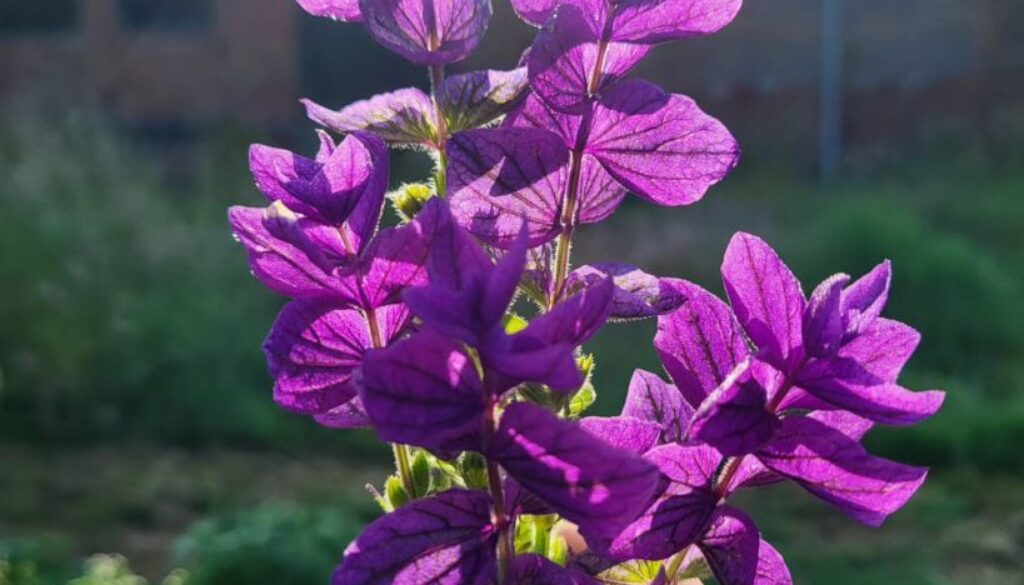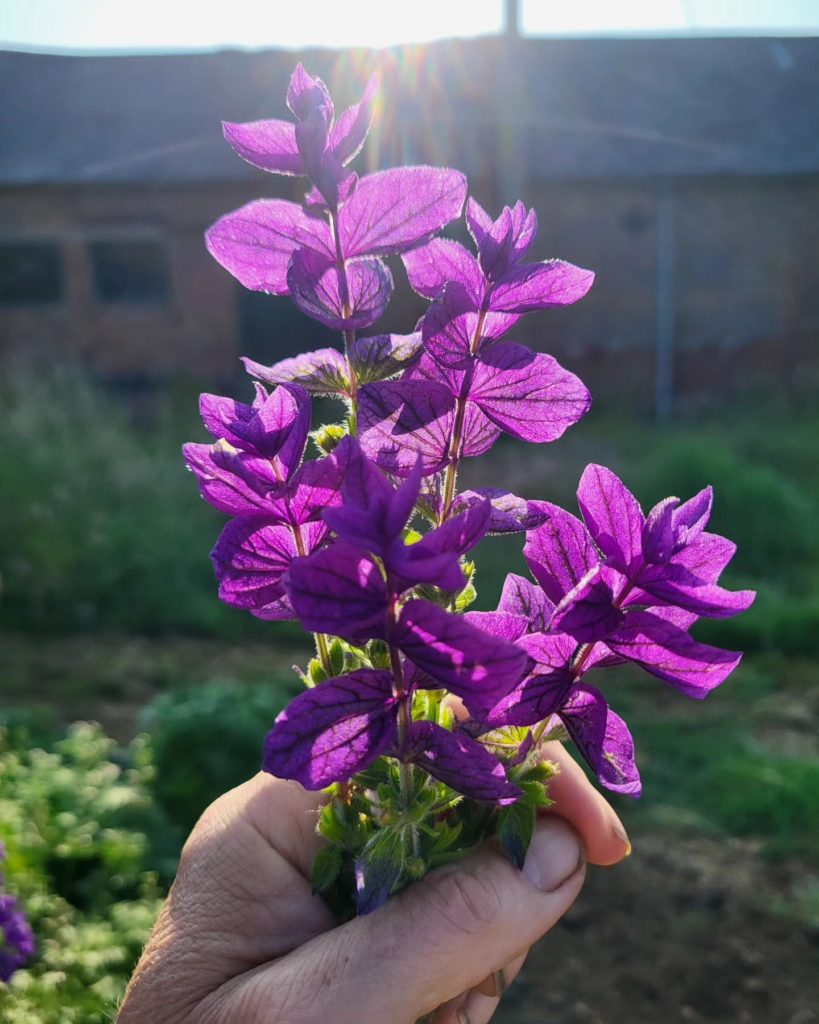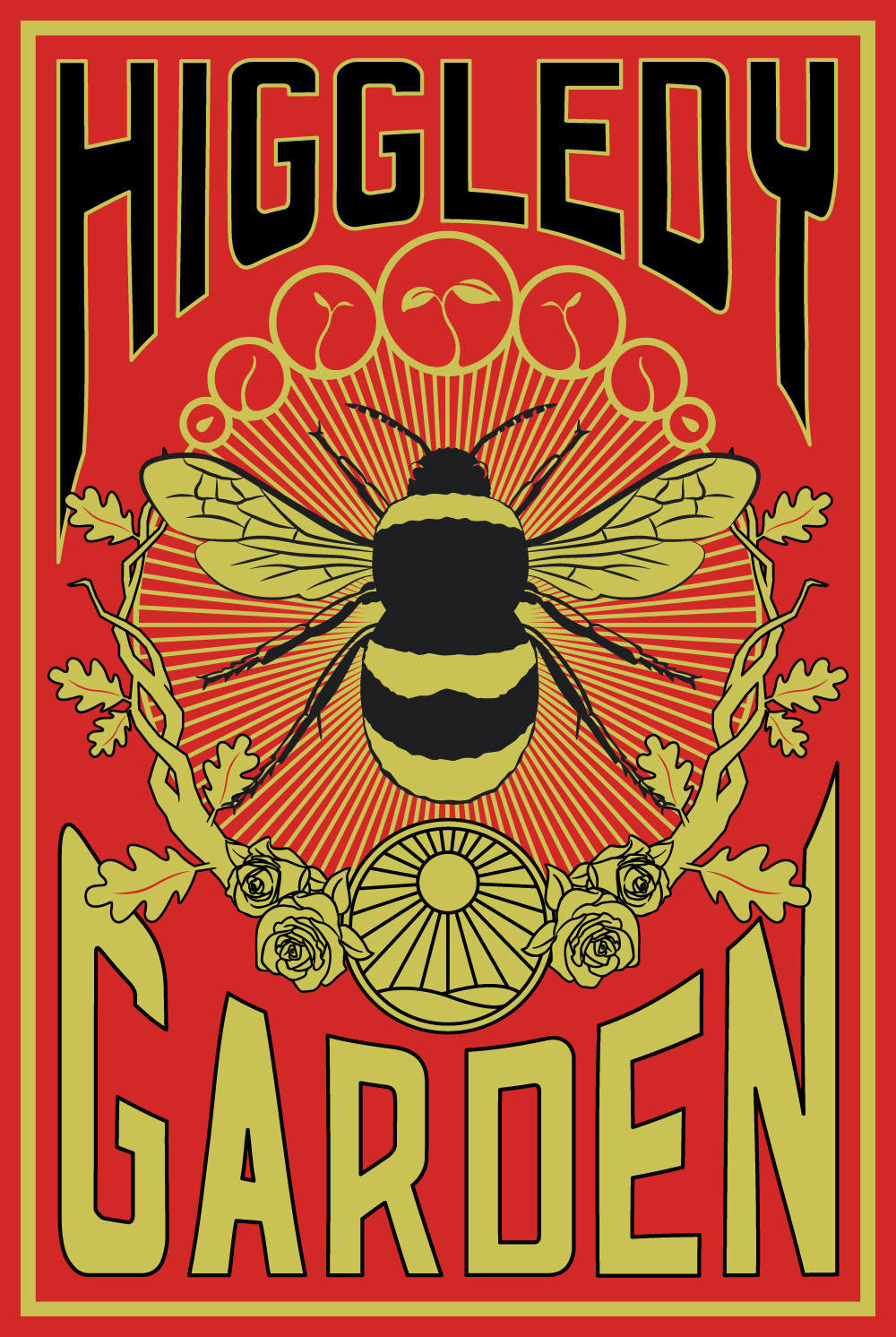Painted Sage (Salvia viridis). A Higgledy ramble.


There’s a spot in the Higgledy cutting beds, just along the path where Flash sometimes pretends not to hear me calling him, that seems to catch the morning sun like a cat catching a beam on a windowsill. That patch, about three paces wide and a stride long, is where I sow Painted Sage — Salvia viridis — and every year it surprises me. Not because it’s rare or fussy, but because it feels like the sort of plant that shouldn’t quite exist. A flower pretending to be a leaf, or perhaps the other way round.
Painted Sage, if you’re not familiar with it (and even if you are, bear with me — it’s a ramble, after all), is a bit of a botanical conjurer. Its flowers are small, almost apologetic, tucked away in the undercarriage. But its top bracts — the coloured bits most folks think are the blooms — are outrageously bright. Think rich magentas, blousy pinks, soft whites, and the sort of blue you’d expect on a Provençal shutter. The bracts stack neatly, like ruffled collars on a 17th-century courtier, and stand bolt upright — giving it a candelabra-like structure, only softer, leafier, and entirely unbothered by Versailles.
Now, Salvia viridis is an annual. A proper annual, mind you — not one of those half-hearted short-lived perennials masquerading as annuals in the seed catalogues. It grows, it dazzles, it sets seed, it bows out. No faff, no drama, just a good honest season of flair.
Growing Painted Sage the Higgledy Way
In my opinion — and I’ll admit I’m biased in favour of anything that doesn’t require mollycoddling — Painted Sage is an absolute gift to the cut flower gardener. It’s hardy-ish but not so much that I’d throw it into a March frost and expect it to come out singing. I usually direct sow it around late April, when the soil’s stopped sulking and is just warm enough to welcome seeds with a handshake rather than a slap.
It germinates reliably in a week or so, quicker if the soil’s got its spring trousers on. And from there, it grows upright, unfussy, and neatly. No staking, no pinching, no “Oh dear, I think it’s got mildew” nonsense. Just a tall-ish (around 45–60cm), self-supporting chap with strong stems and those marvellous coloured tops.
You can sow it in modules if you’re that way inclined. I do sometimes — especially if I want to guarantee a solid succession in the cutting beds — but it doesn’t seem to mind which way it’s born into the world. I just make sure it gets full sun and reasonably well-drained soil. It doesn’t like its roots in cold clag, and honestly, who does?
It’s a wonderful thing to grow among softer, more petal-heavy types. It cuts cleanly, stands well in a vase, and provides a sort of vertical punctuation in a bunch — a botanical exclamation mark if you will.
Aesthetically Bonkers — and That’s the Point
The thing I really adore about Painted Sage is its unapologetic colour. It’s not subtle. Not wistful or ethereal. It’s more like the village eccentric who wears velvet trousers to walk the dog. In a garden that can often tend toward tasteful restraint, Painted Sage turns up with its shirt unbuttoned and a guitar strapped to its back.
The pink form looks like raspberry ripple ice cream turned inside out. The white variety — which isn’t a true white, more of a creamy celadon — is oddly elegant. But the blue… oh, the blue! It’s hard to describe without veering into the realms of over-romanticism, but it’s a proper painter’s blue. Not quite cobalt, not quite ultramarine, but a sort of herbal, almost Mediterranean hue that glows even on a grey Cornish morning.
If you’re arranging flowers, you’ll find it behaves beautifully. The bracts are long-lasting, and they don’t flop or sulk. You can use them fresh, or you can dry them — they hold their form and colour for months, which makes them wonderful for wreaths or winter posies. There’s something pleasingly old-world about drying Painted Sage — as though you’re preparing a herbal remedy or some ancient dye. It’s the kind of activity that makes you want to wear an apron and speak in whispers.
The Bee’s Delight
Another reason to grow Salvia viridis — and this might be my favourite justification — is that bees absolutely lose their minds for it. Particularly the smaller native bumbles. You’ll see them darting into the lower flowers, tucked beneath the coloured bracts, working away with a kind of obsessive joy. I’ve spent too many mornings standing still and watching them, tea going cold in my hand, losing all track of time.
It’s not a nectar factory like some of the more aromatic salvias — Painted Sage doesn’t have the strong scent of its perennial cousins — but it’s still a haven. And anything that invites bees into the garden earns its keep as far as I’m concerned.
Companions and Mischief
Painted Sage is an excellent mixer. It plays well with Ammi, Nigella, Larkspur, and Cosmos — the usual suspects in the cutting garden. I often tuck it into the gaps between taller annuals where it can pop up and surprise me. It looks particularly good when grown in small drifts, with colours mingled rather than strictly separated. I know some folks like to group by colour — a blue patch here, a pink clump there — but I prefer the muddled approach. It looks more natural, more painterly, more like the garden is telling me a story rather than showing off a colour chart.
That said, a block of the blue variety under a row of white climbing sweet peas is not to be sniffed at. That combo once made a visiting florist clap her hands and declare she needed to sit down. (She didn’t sit, but she did buy a bucketful.)
Seeds, Self-Sowing, and Serendipity
Though it’s an annual, Painted Sage will often self-sow if you let it. Not invasively — not like poppies or godetia on a sugar high — but with a light touch. A few plants might appear next spring, often in better spots than where you placed them. I always let a few go to seed, partly for this reason, partly because I like to save the seed myself. It’s easy to collect — just let the bracts dry on the plant and shake them into a paper bag. Very Higgledy.
In Conclusion — A Little Piece of Magic
So there we are. Painted Sage — Salvia viridis — an odd, joyful, striking little plant that feels like it should be better known. It’s affordable, easy to grow, long-lasting in the vase, beloved by bees, and pleasingly bonkers.
If you’ve got a square metre to spare, or even just a few gaps to plug in your annual beds, give it a go. Sow it with a bit of love, give it a sunny spot, and let it show off. You might find — as I do — that it becomes one of those quiet stalwarts of summer, turning up every year like an old friend in a loud shirt.
And if you see Flash lounging beside it, feigning deafness with one eye open — don’t worry. He’s just admiring the colour.
Kindest regards
Higgers and Flash x
